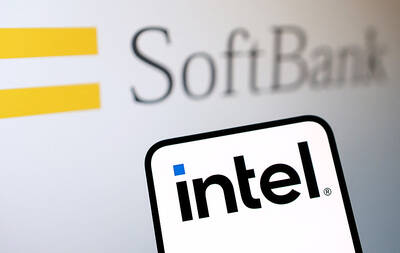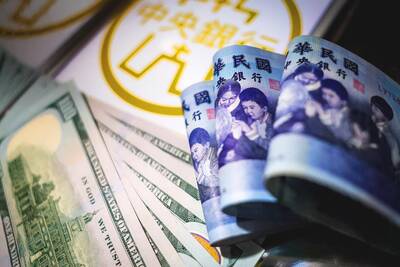The US dollar on Thursday rose against a basket of world currencies, but ended its worst year since 2017 as expectations for further fiscal aid and easy monetary policy from the US Federal Reserve prompted investors to shun the greenback.
The prospect of a brighter year has lessened the lure of the safe-haven greenback, while burnishing the attraction of assets overseas, especially in emerging markets.
News that UK firms would be allowed another three-month transition period for swaps trading on EU platforms, averting the threat of disruptions next week, pressured the US dollar further by sending the sterling to the highest since May 2018.

Photo: EPA-EFE
This week’s data also showed the US trade account hemorrhaging US dollars as the goods deficit hit a record US$84.8 billion in November last year.
The current account gap also widened to a 12-year high in the third quarter.
“I expect the dollar to depreciate further over the next few years as the Fed keeps rates at zero whilst maintaining its bloated balance sheet,” Kevin Boscher, chief investment officer at asset manager Ravenscroft, told clients.
“The magnitude of the twin-deficits dwarfs any other major economy,” Boscher said.
The US dollar index lost 0.01 percent to 89.93.
The greenback’s weakness boosted the euro above US$1.23, the highest since April 2018, with a gain of almost 10 percent for the year.
In Taipei, the New Taiwan dollar closed down NT$0.001 against the US dollar at NT$28.508 on Thursday in a holiday-shortened week, up 0.12 percent from NT$28.541 on Friday last week
Against the yuan, the US dollar breached 6.49 yuan for the first time since mid-2018, although Chinese banks were later reported to be buying US dollars to limit the drop.
Sterling rose as far as US$1.3686, but closed at US$1.3667.
On sovereign bonds, borrowing costs inched lower in thin liquidity, with this year’s top performer, Italy, seeing 10-year yields slip one basis point to around 0.51 percent.
They started the year at almost 1.5 percent, only to drop steadily after the European Central Bank’s stimulus explosion in response to the COVID-19 pandemic.
Spanish and Portuguese 10-year yields hovered above 0 percent, down about 50 basis points on the year. Even German yields, already negative in January last year, fell by about 30 basis points.
After bumper returns last year — 4 percent to 5 percent on 10-year German, Spanish and Portuguese debt, and more than 8 percent on their Italian and US equivalents — yields could grind gradually higher next year.
However, the improving growth picture should be broadly offset by central bank buying.
“Financial repression is very much intact and bond yields will be kept low across the maturity range in order to force investors further up the risk scale in a search for yield,” Boscher added.
Additional reporting by staff writer

Taiwan Semiconductor Manufacturing Co (TSMC, 台積電), the world’s biggest contract chipmaker, booked its first-ever profit from its Arizona subsidiary in the first half of this year, four years after operations began, a company financial statement showed. Wholly owned by TSMC, the Arizona unit contributed NT$4.52 billion (US$150.1 million) in net profit, compared with a loss of NT$4.34 billion a year earlier, the statement showed. The company attributed the turnaround to strong market demand and high factory utilization. The Arizona unit counts Apple Inc, Nvidia Corp and Advanced Micro Devices Inc among its major customers. The firm’s first fab in Arizona began high-volume production

VOTE OF CONFIDENCE: The Japanese company is adding Intel to an investment portfolio that includes artificial intelligence linchpins Nvidia Corp and TSMC Softbank Group Corp agreed to buy US$2 billion of Intel Corp stock, a surprise deal to shore up a struggling US name while boosting its own chip ambitions. The Japanese company, which is adding Intel to an investment portfolio that includes artificial intelligence (AI) linchpins Nvidia Corp and Taiwan Semiconductor Manufacturing Co (TSMC, 台積電), is to pay US$23 a share — a small discount to Intel’s last close. Shares of the US chipmaker, which would issue new stock to Softbank, surged more than 5 percent in after-hours trading. Softbank’s stock fell as much as 5.4 percent on Tuesday in Tokyo, its

COLLABORATION: Softbank would supply manufacturing gear to the factory, and a joint venture would make AI data center equipment, Young Liu said Hon Hai Precision Industry Co (鴻海精密) would operate a US factory owned by Softbank Group Corp, setting up what is in the running to be the first manufacturing site in the Japanese company’s US$500 billion Stargate venture with OpenAI and Oracle Corp. Softbank is acquiring Hon Hai’s electric-vehicle plant in Ohio, but the Taiwanese company would continue to run the complex after turning it into an artificial intelligence (AI) server production plant, Hon Hai chairman Young Liu (劉揚偉) said yesterday. Softbank would supply manufacturing gear to the factory, and a joint venture between the two companies would make AI data

DOLLAR SIGNS: The central bank rejected claims that the NT dollar had appreciated 10 percentage points more than the yen or the won against the greenback The New Taiwan dollar yesterday fell for a sixth day to its weakest level in three months, driven by equity-related outflows and reactions to an economics official’s exchange rate remarks. The NT dollar slid NT$0.197, or 0.65 percent, to close at NT$30.505 per US dollar, central bank data showed. The local currency has depreciated 1.97 percent so far this month, ranking as the weakest performer among Asian currencies. Dealers attributed the retreat to foreign investors wiring capital gains and dividends abroad after taking profit in local shares. They also pointed to reports that Washington might consider taking equity stakes in chipmakers, including Taiwan Semiconductor